Hedging General Maintenance and Care Advice
Hedging is a functional and beautiful addition to any garden and can be used as a windbreak barrier or to create a privacy screen and is a wonderful ornament for the layout of your garden. When adding a new a new hedge to add to your landscape there are several factors to take into consideration such as soil type, light conditions, growth speed, exposure and desired level of maintenance.

- Leylandii, Thuja and Conifers are hardy species that can endure windy, exposed conditions.
- Most varieties can endure partial shade; however Laurel, Firethorn and Box Faulkner will thrive in fully shaded conditions.
- Holly and firethorn and are beautiful varieties that offer Security Hedging (hedging with thorns to discourage intruders).
- If you want a colourful hedge, consider Heavenly Firepower, Red Robin, Pink Marble or Golden Leylandii.
- Thuja is low maintenance choice that does not require frequent side trimming and thrives in most soil types and exposed areas making it great selection for privacy or a windbreak barrier.
With some thoughtful selection while taking garden conditions into consideration your new hedging will define boundaries, create structure and provide you with a lifetime of lush foliage.
Hedging Planting Advice
Although pot-grown hedging can be planted year-round providing the ground is not waterlogged or frozen, there are some seasonal recommendations. Evergreen hedges are best planted in early autumn and deciduous hedges establish better mid-autumn or late winter when the leaves have fallen while they are dormant. However, if you are planting evergreens at a windy and exposed area April to early May is preferable so the frigid winds do not dry out the new pant during the winter.
Plant Spacing
- Plant height 50-100cm (20-40in) -recommended 6 plants per linear meter
- Plant height 100-150cm (40-60in) -recommended 4 plants per linear meter
- Plant height 150-200cm (60-80in) -recommended 3 plants per linear meter
- Plant height 200-250cm (80-100in) -recommended 2 plants per linear meter
- Plant height 250-300cm (100-120in) –recommended 1-2 plants per linear meter
- Plant height 300-350cm (120-140in) –recommended 1-2 plants per linear meter
Ground preparation
- Ideally ground preparation starts 4-6 weeks before planting, using canes and planting line mark an area 60 cm (2ft) wide for a single row hedge and 90 cm (3ft) and separated by 40 cm (16in) for a double row hedge.
- Spray a non-residual weed killer on the trench area according to the manufacturer’s instructions.
- Generally it is recommended to lay Planting Compost 5-8cm (3-5 in) over the immediate planting area and thoroughly mix it in with the soil with a gardening fork as deep as your spade will go after removing the top layer of vegetation before planting. If needed, amend the soil with Horticultural Gravel to improve drainage.
Day of planting
- After laying a gardening tarp parallel to the trench, remove the top layer of vegetation. Then dig the trench 30 cm (1ft) deep and place the soil on the tarp, remove rocks and break up the soil extensively so the roots can establish properly. If drainage is an issue, dig ½ to ¼ deeper and cover the bottom of the hole with Horticultural Gravel, but make sure to cover the gravel with a layer of soil so that the roots do not directly touch it.
- Mix the backfill with 1-1 with Planting Compost and native soil, but remember ericaceous plants need ericaceous compost. Sprinkle a handful of fertilizer into the mix.
- Keep the rootball well watered before planting, preferably soaking it in a bucket of water 2-4 hours before being planted.
- After removing the hedging from the shipping container use a planting line and measuring stick for even spacing, plant the root balls at the same depth as the root line. Pack the area immediately around the root balls to keep them in an upright position.
- After filling in the trench with the backfill, firm the soil down using your foot. Remember you are only firming the soil down; avoid stamping the soil into the hole.
- Water the soil thoroughly but do not waterlog.
- Cover the freshly planted soil with 2-3 inches of Mulching, keeping a3-5cm (1-2in) ring around the base to make sure the mulching does not touch the root.
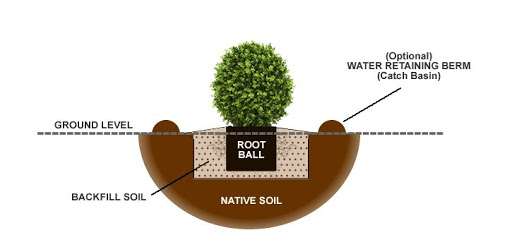
Proper planting will ensure your new cultivar will successfully establish, providing solid root structu re and a healthy plant.
Hedging Trimming Advice
Your new hedge will require formative pruning after it is planted for the first two years at various times depending on species. While it is important for top shoots in your new hedge to grow until it reaches the desired height while trimming the side shoots during the growing season will encourage thick and lush new growth. It is best advised to keep a formal hedge no wider than 60 cm (24 in) and slightly tapered upwards to allow the bottom area to receive ample sunlight.
- Keeping a straight edge is difficult, so we recommend using a string for a guide.
- Complex hedge shapes such as domed, crenulated or pitched forms can be aided with a cardboard template.
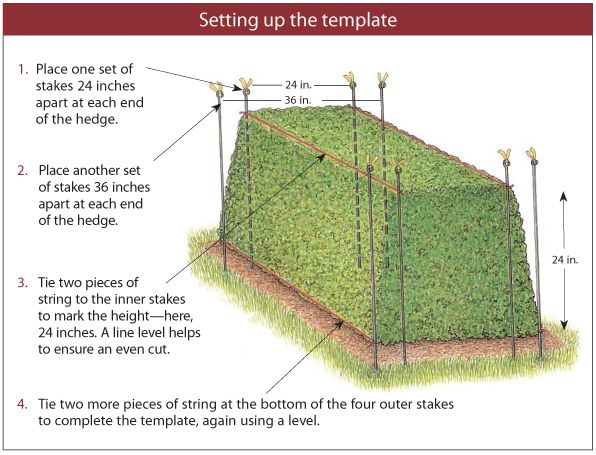 Hand shears and pruners are generally the best options for smaller hedges and are more effective on difficult branches. They are also quieter, less expensive, and a safer alternative to power shears. However, if you have a larger hedge or garden a power shear may be required for the sake of time and efficiency. Electric trimmers are much lighter than petro-powered models, but mind the cord or consider one of the new cordless models.
Hand shears and pruners are generally the best options for smaller hedges and are more effective on difficult branches. They are also quieter, less expensive, and a safer alternative to power shears. However, if you have a larger hedge or garden a power shear may be required for the sake of time and efficiency. Electric trimmers are much lighter than petro-powered models, but mind the cord or consider one of the new cordless models.
- Preferably cut on a cloudy day to avoid scorching.
- Keep your tools sharp and wash them in between plants to avoid the spread of disease
- Yew should be trimmed once a year in August or September and pruned in August to limit overall size.
- Privet should be trimmed twice per year, generally from May to August. The more you trim it the denser and thicker it will grow in, making it easier to keep a uniform size. Prune hard in April for size reduction if necessary.
- Laurel is best cut in July or August, and hard spring pruning can be used to limit size.
- Box should be trimmed twice per year, preferably in May and September-October.
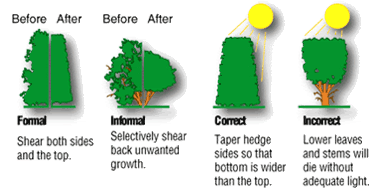 The best times of year for trimming depends on the cultivar, but take care to not disturb birds during the March to August nesting season. With hedging, a little proper and effective maintenance will enrich your plants providing rich, full foliage for decades.
The best times of year for trimming depends on the cultivar, but take care to not disturb birds during the March to August nesting season. With hedging, a little proper and effective maintenance will enrich your plants providing rich, full foliage for decades.
Hedging Watering Advice
Regular watering for 2-4 weeks immediately after planting is essential. If using a watering can, 5 litres (1.5 gal) for every meter of hedging. An automatic irrigation system is preferable, effective an inexpensive; it is laid next to the base of the hedging and turned on for 2-4 hours.
- Water in the evening or when cloudy so the moisture does not evaporate.
- Water every 2-3 days for the first 4 weeks after planting and every week for the first year of planting. After the first full year the roots should establish themselves and not require frequent watering but take care to water during extended dry spells, even during winter dormancy.
Proper watering will allow the roots of your new hedging to establish correctly, resulting in a healthy plant that will enliven your garden for decades to come.
Hedging Feeding Advice
Feed your new hedges several times per year with a good slow release fertilizer in spring, using about 70-80 grams (2-3 OZ) per square meter. Fertilizer needs to seep down into the rooting system, so a good time to fertilize is after a rainfall. After application, cover the planting area with a 5-8 cm (2-3 in) of Mulching and refresh mulch regularly as needed.
A good layer of mulch will also deter weed growth but most importantly it enriches the soil. With nourishment, your new hedging will reward you with healthy, full and dense foliage and a gorgeous garden environment.


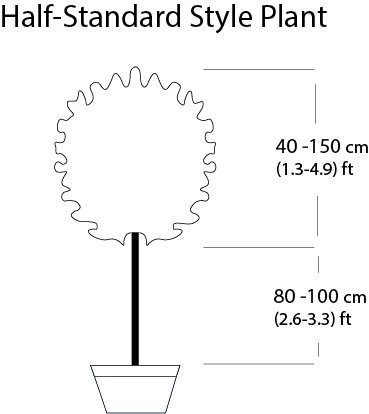




 Hand shears and pruners are generally the best options for smaller hedges and are more effective on difficult branches. They are also quieter, less expensive, and a safer alternative to power shears. However, if you have a larger hedge or garden a power shear may be required for the sake of time and efficiency. Electric trimmers are much lighter than petro-powered models, but mind the cord or consider one of the new cordless models.
Hand shears and pruners are generally the best options for smaller hedges and are more effective on difficult branches. They are also quieter, less expensive, and a safer alternative to power shears. However, if you have a larger hedge or garden a power shear may be required for the sake of time and efficiency. Electric trimmers are much lighter than petro-powered models, but mind the cord or consider one of the new cordless models. The best times of year for trimming depends on the cultivar, but take care to not disturb birds during the March to August nesting season. With hedging, a little proper and effective maintenance will enrich your plants providing rich, full foliage for decades.
The best times of year for trimming depends on the cultivar, but take care to not disturb birds during the March to August nesting season. With hedging, a little proper and effective maintenance will enrich your plants providing rich, full foliage for decades.

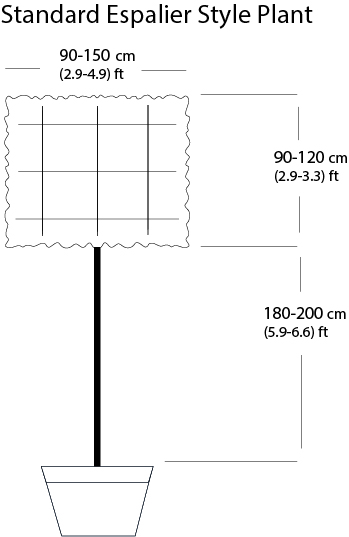 Commonly called the Holly Oak tree, Quercus Ilex often live for more than a thousand years. They are large evergreens with very dense crowns of leaves. They have strong polymorphic leaf of 2 – 9cm long; the younger leaves are wider and have toothed, sharp margins. The colour and texture of the Quercus Ilex varies from hairy, tender and pale green when they first appear to a leathery, dark green, covered in soft white hairs on the underside, when adult. Both male and female flowers are borne on catkins and appear in June, the first ones being the most decorative as they are a soft yellow.
Commonly called the Holly Oak tree, Quercus Ilex often live for more than a thousand years. They are large evergreens with very dense crowns of leaves. They have strong polymorphic leaf of 2 – 9cm long; the younger leaves are wider and have toothed, sharp margins. The colour and texture of the Quercus Ilex varies from hairy, tender and pale green when they first appear to a leathery, dark green, covered in soft white hairs on the underside, when adult. Both male and female flowers are borne on catkins and appear in June, the first ones being the most decorative as they are a soft yellow.